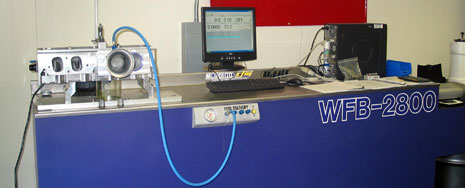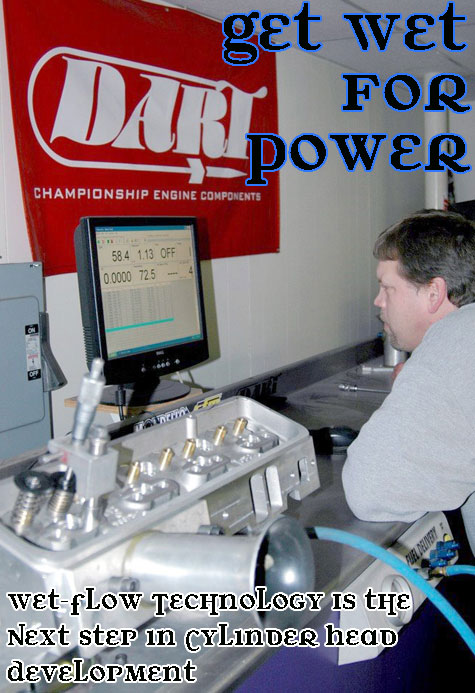We ran a story a couple of years back when Dart first got their wet-flow bench up and functional. Since then it has been tested and refined much more than it was when we first saw it. Plus they learned more about how to use it, so we decided to revisit that story for an update. --Editor
Back in the dawn of drag racing technology, the only barometers of an engine’s performance were the time slip and the seat of the driver’s blue jeans. While Elapsed Time is still the final authority on acceleration, two devices have revolutionized the development of racing engines: the dynamometer and the airflow bench. Once the exclusive property of Fortune 500 manufacturers and corporate-sponsored professional teams, dynos and flow benches have become nearly as commonplace in a professional race shop or speed shop as pocket calculators. Conventional air flow benches have advanced the state of the engine-building art for nearly a half-century but they have one serious shortcoming: they can only measure the flow of “dry” air.

It’s often said that an engine is an air pump, but in fact an engine also moves a considerable volume of fuel/air mixture through its induction system and cylinders. After all, it is that fuel that contains the energy that makes horsepower. Burning more fuel produces more power – providing combustion efficiency is maintained. Unfortunately, a conventional flow bench that only measures dry airflow can’t simulate this crucial characteristic of an internal combustion engine.
Thus begins the age of wet-flow brench testing, heralded by a new generation of wet flow benches that represent the next step in the continuous evolution of racing technology. We visited Dart’s Performance Technology Center in Troy, Mich., to get the inside story on wet-flow testing.
Richard Maskin, the founder and president of Dart, is a certified gearhead and an ardent believer in the value of wet-flow testing. Since he founded Dart in a two-car garage in suburban Detroit 24 years ago, Maskin has seen his business expand to a staff of nearly 100 employees who producing both state-of-the-art cast-iron and aluminum cylinder heads and blocks. Despite the demands on his time to run his manufacturing business, Maskin manages to maintains a hands-on approach to engine building, and has built V-8 gasoline burning engines that have won three NHRA Pro Stock championships using Dart’s fully equipped in-house engine shop, and R&D facilities.
“We’ve made a commitment to invest in both equipment and people to give Dart the in-house capabilities to produce winning parts for racers,” Maskin explained. “The wet-flow bench is a key element in our development process, which I call ‘Speed Flow Technology.’ It’s an integrated approach to developing parts that combines high-tech digital design and manufacturing with testing on the flow bench, in the dyno cell and on the race track to produce real-world results.”
One glance at Dart’s wet-flow bench confirms the depth of Maskin’s commitment. The computer-controlled wet-flow bench fills an entire workroom. It’s powered by three 50-horsepower, 440-volt electric motors that must put a serious strain on Michigan’s power grid. A complex system of tanks and pumps separates the liquid from the air after it has passed through the test section. This monster machine can flow 800 cubic feet per minute at a vacuum of 55 inches of water. For comparison, the industry standard for dry-flow testing is 28 inches of water.
“We measure the wet-flow numbers at points that correspond to when the depression in the cylinder is highest and the piston is moving the fastest, typically between .400-inch to .700-inch of valve lift,” said Tony McAfee, who ramrods Maskin’s cylinder head R&D program. “Our standard wet-flow test is run at a depression of 55 inches of water with a 13:1 air/fuel ratio. The bench continuously monitors and adjusts the fuel flow to maintain the correct ratio throughout the test.”
 Words by Jonas McElryd
Words by Jonas McElryd